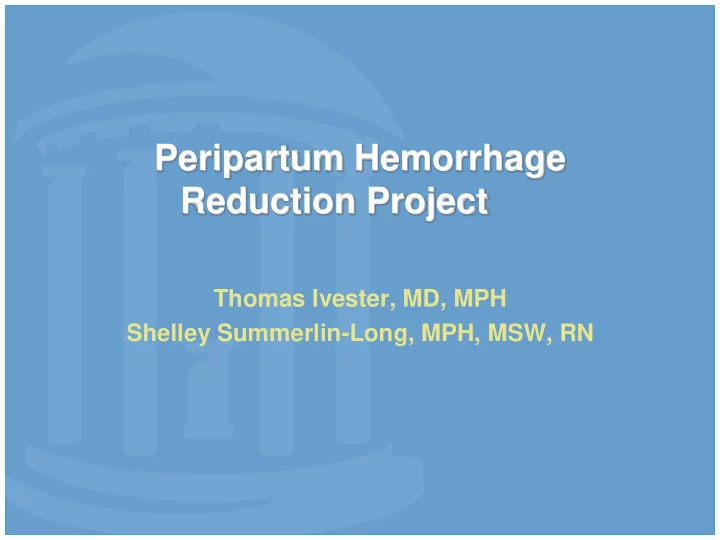

Peripartum Hemorrhage Reduction Project Thomas Ivester, MD, MPH Shelley Summerlin-Long, MPH, MSW, RN
A Hemorrhage Story
Definition • Peripartum hemorrhage (PPH) » blood loss around the time of delivery of 1000 ml or more » 10% drop in a patient’s hematocrit » Need for immediate transfusion
Prevalence of PPH 12 10.5 10 8 7.3 6 Percentage 6 3.5 4 2 0 U.S. Globally UNC Africa
UNC OB Hemorrhage Rates, 2010-2015 10.4 UCL 9.39 9.4 8.4 7.9 Percentage 7.5 7.6 7.27 CL 7.4 7.1 7.3 6.4 6.2 5.4 LCL 5.14 4.4 2010 2011 2012 2013 2014 2015 Year
Why is this important? NC Women’s Hospital – 3 rd largest consumer of blood • products in the hospital • Hemorrhage a leading cause of maternal morbidity and mortality in U.S. and globally • Responsible for 25% of maternal deaths » Most of these are preventable!
Project Aims Short-term: Develop the necessary tools and resources to ensure UNC can provide efficient, effective response to PPH Primary: Reduced incidence of PPH and associated maternal morbidities Decreased use of blood products Secondary: Increased use of preventative and early intervention measures Enhanced teamwork among obstetrical providers and staff Improved identification of high-risk patients 7
INITIAL STEPS 6/1/2016 8
Hemorrhage Cart and Tackle Boxes
Virtual Med Kit
Simulation Program
Prioritizing Next Steps Chart Reviews (100) + Hemorrhage Surveys (173) + Data Analysis Root Cause Analysis Provider Observations (10) + Simulation Evaluations (5) Next Steps: (1) Hemorrhage Protocol Solutions Brainstorming Multi-voting (2) TeamSTEPPS (3) Clinical Education
Hemorrhage Protocol • Risk identification • Standardization of treatment • Role clarification • Development of checklists • Based on evidence-based practice • Makes it easier for people to do the right thing
Stage 1: Primary Charge OB, FM or Second RN RN CNM RN -Call primary provider to bedside -PPH Med kit & fluids -ID and treat as per -Notify charge RN -Warm blankets etiology -Med/IV fluids -Weigh pads and EBL -I&O catheter -Vitas q5 q5-10 T&C x 2u -O 2 PRN Sat >95% -Document -Fundal massage -In/outs -Assign 2nd RN -PPH Cart -Notify as needed: -Anes -OB/FM -Scrub -Blood bank -Assign runner for blood bank PRN
TeamSTEPPS • Trainings in May and June for all Labor & Delivery providers and staff » OB, Family Medicine, Midwives, Anesthesia, Nursing, Staff Some of theTeamSTEPPS Coaches Simulation Debrief
Clinical Education
Hemorrhage Rates at UNC Jan 2015-Jan 2016 14.7 12.7 UCL 12.20 10.7 9.3 9.3 9.1 Percentage 8.7 7.7 8.1 7.8 7.7 CL 7.25 7.6 6.7 6.5 5.8 5.7 4.7 5.0 4.7 2.7 LCL 2.31 0.7 Jan Feb Mar April May June July Aug Sept Oct Nov Dec Jan Month
Blood Transfusions at NC Women’s Hospital December and January data 60 not available 44 50 42 38 40 32 24 28 30 20 20 11 10 5.1 3.2 4.6 4.1 2.7 2.0 3.0 4.8 0 Jun Jul Aug Sept Oct Nov Feb Mar # Blood Products Issued on L&D, Postpartum Blood Transfusion Rate on L&D, Postpartum Transfusion rate = % deliveries receiving any blood product; # blood products issued includes red blood cells, plasma, and platelets
Simulation Scores, Oct. 2015 - Apr 2016 100 87 90 94 76 87 80 78 70 54 60 55 50 40 30 20 10 0 Oct Nov Dec Jan Feb Mar Apr
From an Intern. . . I had the opportunity to participate in several simulations. I think so often in intern year we are faced with [complicated] clinical scenarios . . . Our moment-to- moment lives at work are so filled with responsibilities that sometimes it's difficult to digest what you did well and what you could have improved on. The simulation sessions offered me that opportunity. I certainly felt that in real-life postpartum hemorrhages after the simulations, I was more conscious of the clinical situation and my actions and communication techniques within it. 20
Another Hemorrhage Story
Sustainability Plan • Interdisciplinary Team » Champions in each department: OB, Nursing, Anesthesiology, Midwives, Family Medicine, Pharmacy, Simulation, QI • Commitment to continue simulations • Investment in clinical education
Dissemination Plan
Lessons Learned • Challenges in creating a sim culture • Strengths in bringing all disciplines to the table • Importance of gathering data at the source • Need for structural & administrative support for QI
Recommend
More recommend